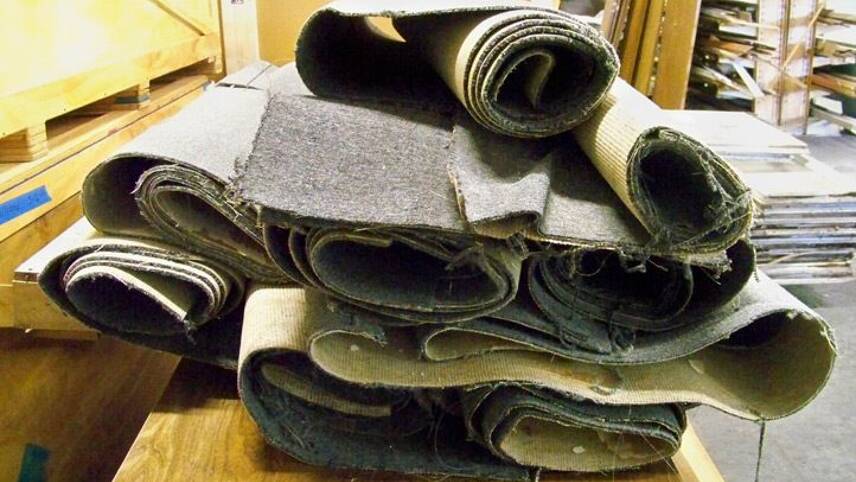Register for free and continue reading
Join our growing army of changemakers and get unlimited access to our premium content

The report authors are urging Ministers to speed up the introduction of new waste and resources legislation around carpets. Image: Reuse Warehouse/ CC BY 2.0
The research, conducted by Changing Markets Foundation and Zero Waste Europe, examined what happened to the carpet waste which is handled by industry body Carpet Recycling UK (CRUK) on an annual basis.
It found that, of the 130,000 tonnes of carpet processed by the organisation annually, less than 2% is recycled.
CRUK states on its website that 44% of the carpet it receives is diverted from landfill – up from 2% when it was first founded in 2008. But the new research concluded that almost three-quarters of this diverted material in 2018 was incinerated; less than 2% was recycled without the use of shredding; and less than 1% was reused in its existing form. The majority of the remaining material is shredded and used as a surface for outdoor equestrian arenas, making it difficult to further reuse or recycle.
In addition to a waste problem, Changing Markets Foundation and Zero Waste Europe claim that this trend towards incineration is causing harm to nature and to human health. Their report cites previous research from The Centre for International Environmental Law which found that carpets sold within the EU can contain more than 59 toxic chemicals and that incinerating carpets with PVC content “releases toxic substances including heavy metals such as lead and mercury, acid gases and particulate matter”.
Responding to the report’s findings, a CRUK spokesperson said the organisation “has always been transparent about its achievements and has never ‘swept anything under the carpet’”.
The spokesperson said: “Incineration of carpet waste as a percentage of the total waste sent to energy from waste (EfW) schemes in the UK (circa. 10.8 million tonnes in 2018) is just over 1%It is important to note that carpet waste is combined with other non-recyclable or difficult to recycle materials and converted into a refuse derived fuel or solid recovered fuel feedstock, which is then sent on to either energy from waste plants or the cement industry where it is used as a replacement for virgin fossil fuels.”
Based on its findings, Changing Markets Foundation and Zero Waste Europe are urging CRUK to publicly support ongoing calls for stronger Extended Producer Responsibility (EPR) legislation in the UK. The Government is due to begin consultations on changing EPR regimes for products including textiles, mattresses, carpets and furniture in 2020 and to introduce such frameworks by the end of 2025, under its Resources and Waste Strategy.
CRUK, meanwhile, claims it is already working with policymakers on issues of design and waste.
“Since its formation and as the only professional body representing our sector, CRUK has worked hard to try and influence local and central government policy,” a CRUK spokesperson said. “In the absence of such, it has worked on a voluntary basis with its members to develop alternative solutions and in some case best practice measures, which we will continue to do, and which will help us continue to move carpet waste up the waste hierarchy in the future.”
Policy-level action
While the report specifically analyses carpet processed through CRUK, it also takes a broader look at the UK’s waste challenges in this area. It states that UK businesses and households throw away 400,000 tonnes of carpets annually – enough to cover an area the size of Birmingham – most of which is landfilled or burned.
In order to tackle this issue at a national scale, the bodies behind the report are urging Ministers to speed up the processes detailed in the Resource and Waste Strategy and incentivise carpet designers, manufacturers and retailers to shift towards products with longer lifespans and better recyclability.
They are additionally calling for the Strategy to be bolstered with mandatory green design measures; better customer-facing labelling requirements; consumer information campaigns and green procurement requirements, to ensure supply chains free from toxic chemicals.
Firms within the flooring sector, the report notes, should also act faster than policymakers and invest in “rapidly scaling up” recyclable, non-toxic solutions and recycling infrastructure.
Some businesses are already taking such steps, including Interface, which produces only carbon-neutral products and is using circular economy innovations throughout the life-cycle of its flooring. Similarly, Tarkett makes recyclable new flooring using recycled components from old flooring, with recycled content accounting for 10% of its total annual material purchases. The firm has also recently unveiled 100% recyclable carpet made using Aquafil’s ECONYL yarn, which is made using recycled fishing nets.
“As the reports shows, voluntary agreements are limited and avoid tackling the heart of the waste crisis by focusing instead on downstream initiatives, such as incineration and downcycling. What is needed in the carpet sector is binding and ambitious policies that tackle the problem at its source by ensuring carpets are designed to be adequately handled at end of the life,” Zero Waste Europe’s consumption and production campaigner Larissa Copello said.
“EPR is a crucial policy tool to ensuring the circularity of carpets as fee modulation within EPR has the potential to encourage producers to better design their products, rewarding toxic-free, reusable and fully recyclable carpets. In fact, a number of major carpet producers in Europe already support mandatory EPR schemes as way to drive change towards a circular economy.”
Sarah George


Please login or Register to leave a comment.